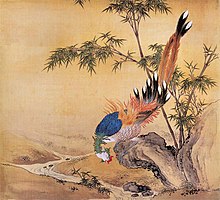Yu Sheng or Yu Xing[1] (Chinese: 余省, 1692–after 1767[2]), courtesy name Zengsan (曾三) and art name Luting (魯亭),[3] was a Chinese court painter in the Qing dynasty. A native of Changshu,[3] he studied with Jiang Tingxi and entered the Imperial Academy afterwards.[4] Many of his best paintings themed in flowers, birds, insects, fish. He used not only traditional Chinese painting methods, but also European painting techniques.[1] In 1741, along with Jin Kun, Sun Hu, Ding Guanpeng, Zhang Yusen, and Zhou Kun, he was granted the top rank by the Qianlong Emperor which entitled him to eleven taels of silver per month.[5]

He was the son of Yu Xun (余珣[3]) and the brother of another court painter, Yu Zhi.[5] The brothers were in the residence of the politician Haiwang for two decades[5] before they were summoned to the capital in 1737.[6]
References
edit- ^ a b Li Xiangping (2007). Flower-and-bird Painting in Ancient China. Translated by Shao Da. China Intercontinental Press. p. 114. ISBN 978-7-5085-1128-3.
- ^ Finlay, John R. (2011). "40 Views of the Yuanming yuan": Image and Ideology in a Qianlong Imperial Album of Poetry and Paintings (Ph.D. thesis). Yale University. p. 359. Retrieved 10 February 2022.
- ^ a b c Walravens, Hartmut; König, Albert (2020). Roter und gelber Papagei (Ara macao und Psittacula krameri, gelbe Mutation) am Kaiserhof in Peking (in German). p. 7. ISBN 9783752626445. Retrieved 10 February 2022.
- ^ Kondō, Hidemi (1989). "Shen Nanpin's Japanese Roots". Ars Orientalis. 19: 81. JSTOR 4629388. Retrieved 10 February 2022.
- ^ a b c Nie Chongzheng. "A Treatise on the System of Court Paintings in the Qing Dynasty". Macau Museum of Art. Retrieved 10 February 2022.
- ^ Yang Boda. "The Development of the Ch'ien-lung Painting Academy". In Murck, Alfreda; Fong, Wen C. (eds.). Words and Images: Chinese Poetry, Calligraphy, and Painting. Translated by Jonathan Hay. The Metropolitan Museum of Art, Princeton University Press. p. 341. ISBN 0-87099-604-5. Retrieved 6 March 2022 – via archive.org.